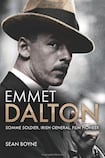
In the aftermath of the death of Michael Collins some fanciful assertions were made about what his last words had been, with suggestions that he had articulated forgiveness for those who had ambushed him and his colleagues. It is much more likely, however, that Collins's last words were the more prosaic, "Emmet, I've been hit," these words being addressed to Emmet Dalton, in whose lap he died a few minutes later.
Dalton, who outlived Collins by more than 50 years, forever remembered that traumatic day and was certainly never willing to forgive. Shortly before he died, at the age of 80, in 1978, he agreed to return to Béal na Blá, in Co Cork, for the making of a documentary, but he tersely dismissed a suggestion that he might meet surviving members of that IRA ambush party from August 1922: “If their only claim to fame is that they shot at me from behind a wall, I don’t want to meet the bastards.”
That was an understandable response from a Civil War veteran who had been devoted to Collins. Dalton’s experiences in 1922, however, when he was just 24,were only one chapter of a remarkable life. It’s all faithfully recorded and explained in Seán Boyne’s fine book, which does justice to a long and interesting career and is admirably devoid of jargon and judgment, and driven by evidence rather than sentiment, nostalgia or hero worship.
Boyne’s considerable archival research underpins what is the first and long overdue biography of a man who was born into a prosperous nationalist family and whose service in the British army, which he joined in 1915, at the age of 17, was a formative influence. Dalton played a significant role in the War of Independence and Civil War, and later became a film producer.
Another death Dalton witnessed was that of his fellow soldier Tom Kettle, the academic and former nationalist MP, during the Battle of the Somme in 1916. A distinguished young soldier, Dalton was awarded the Military Cross for his efforts in Ginchy and later served in the Middle East, gaining skills as a military instructor. When he returned to Ireland he put these abilities to use for the benefit of the IRA, in which his brother Charlie was also active.
Emmet, who according to one contemporary could display “sheer, unadulterated nerve”, was assistant director of IRA training and took part in an audacious though failed attempt to rescue Seán MacEoin from prison. He developed a bond with Collins, was sworn in to the Irish Republican Brotherhood and accompanied Collins to the Treaty negotiations. There is a lack of detail about the extent of his input, beyond “Collins availed of Dalton’s military expertise in side-talks with the British on defence matters”.
Ultimately, Dalton came to believe that the Dáil vote in favour of the Treaty made it legitimate and those who opposed it mutineers. Acting as the IRA’s chief liaison after the truce and during the transition to the Free State, he was immersed in dealing with breaches of the truce, lawlessness, requests from the families of those “disappeared” by the IRA, and the evacuation of crown forces.
The rich detail here, from both British and Irish archives, reveal that Dalton took a hands-on approach to routing the anti-Treaty IRA from the Four Courts at the start of the Civil War and during the war’s initial stages in Dublin. By July 1922 Dalton was in charge of the National Army’s eastern command, leading the advance on Wicklow.
The book is at its strongest in providing a detailed insight into the conduct of the Civil War from the National Army’s perspective; private correspondence makes it clear that, despite the advantages it had in numbers of soldiers and equipment, there were many deficiencies. One of Dalton’s early observations was that “we have NO intelligence system. The necessity for protecting this branch is being made glaringly obvious this day.”
Cork command
In shifting attention to Cork, Dalton was also a strong advocate of seaborne landings “to squeeze the republican fighters from every direction”. The advance by sea to Passage West was rightly regarded as audacious and effective, but neither it nor Dalton’s stewardship was as straightforward as propaganda claimed; there was discreet assistance from the British navy, and Dalton was also frantic in his correspondence with Collins about lack of reinforcements. (“I am at a standstill”, he wrote on August 11th.)
He expressed frustration at having to spend so much time in Cork meeting dignitaries and dealing with civil issues. The book is also a reminder of the constant quest to recapture government revenue seized by republicans.
Boyne’s account of the lead up to the Béal na Blá ambush, its impact and its aftermath is detailed, moving and gripping. The book is also a reminder of the extent of British army service for those fighting on both sides; Sonny O’Neill, a member of the IRA ambush party and believed by some to have fired the fatal shot, was also a former British army man.
As the war continued, Dalton, whom some unfairly blamed for Collins’s death, became increasingly frustrated in Cork; he constantly pressed for his command area to be better defined and was angered by the lack of co-operation he received from Eoin O’Duffy, chief of the southwestern command.
Dalton demanded draconian measures for republicans involved in orchestrating what he described as “diabolical death traps”, insisting, “I must bring martial law or remain impotent”. He also acknowledged that he could not control some of his soldiers after horrific events such as the killing of seven National Army troops at Carrigaphooca. His communications to Richard Mulcahy, who succeeded Collins as National Army commander-in-chief, were particularly revealing in that regard.
In the midst of all this Dalton married Alice Shannon at the Imperial hotel in Cork; the same night in that hotel a National Army soldier shot a fellow soldier.
Dalton’s departure from the army that November was a surprise; it is apparent he was uncomfortable about indiscipline, lack of resources and the execution of republican prisoners. There were 1,800 republican prisoners in Cork, he informed Mulcahy, and he wondered was he expected to execute them: “I am beginning to lose hope.” Dalton’s conclusion about the Civil War – “we like to think we fought a clean fight” – was suitably vague.
Boyne occasionally speculates too much – “he probably” or “he may have” feature a lot – or parks issues that need elaboration. But this is partly down to a lack of private correspondence covering some periods of Dalton’s career and, perhaps, because of the need to leave enough space to document Dalton’s post-Civil War life.
Dalton became clerk of the Senate (“a pretty dull place”), where he lasted only three years. He fell on hard times; worked as a salesman; drank heavily before giving up alcohol for good; spent time working as a private detective and honing his considerable golf skills; and then moved to England to gamble on horses.
Brother’s insanity
This restlessness is hardly surprising given what he had experienced in combat; Dalton fared a lot better than his brother Charlie, who by 1941 was a patient at Grangegorman psychiatic hospital and received a disability pension “in respect of delusional insanity”.
Emmet worked for Paramount films in London and became a representative for the Hollywood film-maker Sam Goldwyn in the late 1940s. He was later involved in Hannah Weinstein's popular TV series The Adventures of Robin Hood. These experiences led to him developing ideas for Irish film production, and often frustrating collaborations with the Abbey Theatre to adapt some of its plays for television.
Dalton bought Ardmore House for £5,000 and won government backing to turn it into a film studio. Notable achievements included the 1959 films Shake Hands With the Devil, starring James Cagney, and This Other Eden, starring his daughter Audrey Dalton. Other films were less successful, and by 1963 his company had gone into liquidation.
Dalton never did realise his ambition to make a film about Michael Collins – “My love for Collins has not altered one iota,” he declared in 1976 – but the author makes the case for him as a key figure in the evolution of Irish film-making.
Some of his other correspondence that decade revealed the ongoing Civil War enmities; in a letter to a friend in 1966 he referred to de Valera as “the sanctimonious hypocritical megalomaniac”.
The legacy of that period was still relevant when Emmet Dalton died, in 1978: the Fianna Fáil government did not send a representative to his funeral.
Diarmaid Ferriter is professor of modern Irish history at University College Dublin. His new book, A Nation and Not a Rabble: The Irish Revolution 1913-1923, will be published in March by Profile Books











